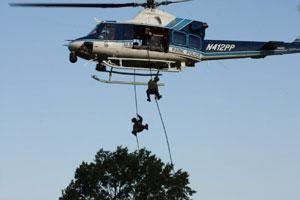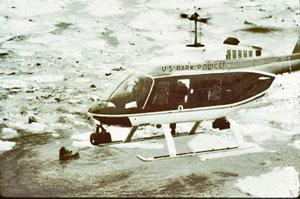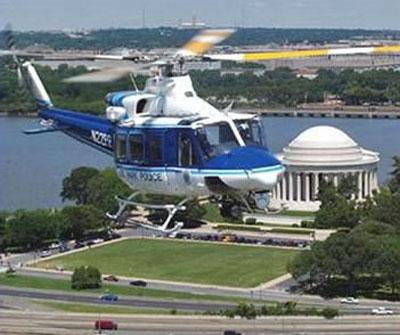News of a dramatic rescue via helicopter in a national park often involves locations like Yosemite or Grand Teton National Parks, but there's also an elite National Park Service helicopter rescue team based in the East. This year marks 40 years of service by the United States Park Police (USPP) Aviation Unit, and the group has been involved in some unusual and high-profile incidents.
When the situation is grim in and around the nation's capital'and I'm not referring to politics' one of the "go-to" units for emergency response is the USPP Aviation Unit, which offers a rather unusual set of capabilities: a fleet of three helicopters and a small group of highly trained personnel that includes a commander, seven police officer pilots and seven police officer rescue technicians who are also nationally-registered paramedics. A full-time maintenance supervisor makes sure the aircraft are ready to go at a moment's notice.
Hundreds of Missions a Year
The Unit flies between 700 and 1,000 flight hours each year, conducting from 200 to 400 medical evacuations, plus additional rescues in areas such as Great Falls Park, Shenandoah National Park and other NPS sites in the region. The Unit also flies numerous law enforcement and homeland security missions.
There's plenty of variety in the terrain the crews encounter, from buildings along crowded city streets in downtown Washington, D.C., to river rapids, canyons and mountains in rural areas of Virginia and Maryland. For just one example of the value of the Unit's combination of law enforcement, rescue and medical expertise, we don't have to look any further than last week's tragic shootings at the Washington Navy Yard.
Early in the incident, while the shooter was still at large and police on the ground searched the building for a still unknown number of gunmen, the USPP helicopter dubbed "Eagle One" flew to the scene, successfully hoisted a wounded woman from the roof the building and flew her to a hospital. The crew then returned and brought to safety the three men who had carried the victim to the roof of the structure.
Medivac Plus Active Shooter Equals Major Challenges
It's not often that a medivac flight needs to approach a destination with a crew member perched in the open door of the helicopter, armed with an M-16 and scanning the area for trouble'but that capability helped make this mission possible.
Sergeant Ken Burchell was the pilot in command of the flight, and he and his crew were fully aware that hovering a helicopter over the building while the victim was being hoisted to safety was a risky proposition. During an interview afterwards with NBC4 in Washington he noted, "Active shooter was definitely part of our thought process. We were well aware that we were a big, fat, blue and white target."
The Unit has plenty of other experience in challenging situations.

Park Police personnel train with the Aviation Unit for a variety of situations. Photo from Wikemedia Commons.
On the morning of September 11, 2001, personnel from several organizations were involved in a large training event at the Aviation Unit's base in Anacostia Park, just southeast of downtown D. C. They were preparing for demonstrations and possible violence during meetings later that month of the International Monetary Fund (IMF) and the World Bank in Washington, DC.
That training session meant more personnel than usual were on hand that morning at the Unit's base, which made it possible to quickly launch two USPP helicopters following the terrorists' attack on the Pentagon. The Unit's personnel were among the first outside responders to arrive on the scene, only five miles by air from their base. With roads clogged after the attack, air evacuation played a key role in the evacuation of dozens of critically injured victims to area hospitals.
Air Florida Flight 90 Rescue
Perhaps the most dramatic rescue for the Aviation Unit occurred on the afternoon of January 13, 1982, when Air Florida Flight 90 struck the 14th Street Bridge shortly after takeoff from Washington's National Airport. The plane, with 79 people onboard, then disappeared beneath the icy waters of the Potomac River, frozen by a major blizzard which had struck the city the day before.
Six survivors from the plane struggled to the river's surface, but land-based rescuers were unable to reach them safely. USPP pilot Don Usher and Rescue Technician Mel Windsor were on duty at the Aviation Unit's base nearby when they learned about the crash, and were soon hovering over the scene.
The USPP helicopter in those days had no hoist capability, so Usher managed a tricky hovering maneuver just above the ice-choked water. You can read about the rescue on pages 360-361 of the book, Death, Daring and Disaster ' Search and Rescue in the National Parks, where author "Butch" Farabee quotes from the Department of Interior Valor Citations later awarded to the two USPP officers:
"Amid freezing temperatures and blowing snow, Officer Windsor exited the helicopter while in flight, throwing a flotation ring and two life vests to the survivors. While standing on the skids, holding onto the helicopter, he dropped a rescue rope...Despite severe weather conditions, Officer Usher lifted the helicopter and raised the victim out of the water, transporting her ...[to safety on the nearby shore.] "Eagle One" returned to the wreckage and rescued three more survivors in similar fashion.

USPP helicopter Eagle One rescues survivors from the crash of Air Florida Flight 90. NPS photo.
One of those victims had managed to get into a life vest, but was unable to continue her hold on a lifeline. "After several failed attempts with the lifeline, Officer Usher lowered the helicopter to a point where the skids were immersed in the icy waters, enabling Officer Windsor to pull the woman onto the skid with him."
It was an incredibly risky maneuver, and in addition to the DOI Valor Award, Officers Usher and Windsor's efforts were recognized with Carnegie Medals and several other awards.
Fortunately, most of the missions for the Aviation Unit, while still challenging, are a bit more "routine," at least by their standards.
Whitewater Rescues on the Doorstep of the Nation's Capital
A common scene of rescues over the years has been the Great Falls of the Potomac, a challenging stretch of whitewater just a few miles outside of Washington, D. C. Some people fail to heed warnings, underestimate the river or overestimate their boating skills, and the Aviation Unit's hoisting capability has proven especially valuable when people find themselves stranded on rocks in the middle of the river.
One such rescue, in March of this year, was captured on this short video. Accidents will happen, and not every hoist-aided rescue at Great Falls Park involves the river, as evidenced by a romantic miscue in Great Falls Park that was reported in the Traveler back in 2009.
Shenandoah National Park is within flying range of the Aviation Unit's base in Washington, D.C., and that park has been able to use the Unit's hoisting capabilities on several occasions. A good example of the value of the helicopter to both victims and ground-based rescuers is found in an incident last May in the park, when a 42-year-old hiker suffered a back injury in a fall near the summit of Old Rag Mountain.
According to a park report, "EMS and rescue personnel hiked to his location and found him to be stable but in need of litter evacuation due to his injuries. Extrication by ground would have taken from eight to ten hours and would have included multiple technical raisings and lowerings that might have worsened his injuries. The weather forecast called for heavy thunderstorms later in the evening with significant rainfall and lightning. A call was therefore made to the Park Police Aviation Unit, and around 6:45 p.m. Eagle 2 headed to the park. The man was hoisted from the mountain and flown to a hospital for treatment."
The short video below shows a successful hoist operation from another rescue at Shendoah's Old Rag Mountain.
In an interview with WUSA Channel 9 following that successful rescue of four people from the roof of the Washington Navy Yard building last week, Sergeant Ken Burchell calmly summed up forty years of service by the U. S Park Police Aviation Unit: "Those people were in a bad situation, and that's what we do'get people out of bad situations."
They do indeed.




Comments
During the years in the 1980's that I rode ambulance for the Red Cross at major events in the D.C. area, Eagle One was the best. It was a comfort to know that they had our backs, and that no matter the circumstances, our patients could be evacuated.